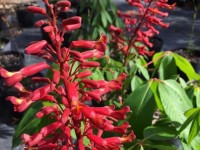Up for sale One grafted plant of Tilia tomentosa 'Green Mountain'
The Silver linden Green Mountain (Tilia tomentosa ‘Green Mountain’) is a fast-growing tree with upright branches reaching heights of 50 to 70 feet with a spread of 40 to 60 feet. The tree is native to Europe and Asia and is popular in this country as a street tree because it is relatively free of disease and its canopy creates a dense shadow in the summer. The leaves of the Silver linden are 4 to 5” long have acuminate tips and serrated edges They are green above and silvery below which creates a shimmering effect when the leaves move in the breeze. In the early summer, the rich-scented flowers are intoxicating (= lethal) to bees; nevertheless the tree is used as a source of nectar for honeybees in Southeastern Europe. This tree features a light gray bark; smooth on young trees becoming more ridged on mature specimens. In the fall the leaves of Silver Linden turn pale green to pale yellow. The ‘Green Mountain’ variety is a cultivar and reportedly more resistant to Japanese beetle and gypsy moth. In the past this species has also been known as Tilia argentea. (The epithet is taken from the Latin word argentum for “silver”). The white of the underside of the leaf is due to the white color of dense hairs (tomentose) . This species was introduced to Britain and America in 1767. It was named by the German professor of Botany in Marburg, Conrad Moench. The genus name comes from the Latin name for Linden or lime tree, Tilia. In southern Sweden it is known as the linn or lind tree and was the origin of the family name Linnaeus. The common name “basswood” is derived from bastwood in reference to the tough inner bark (the bast) which was used to make rope and mats.
Common name: Silver Linden, Silver Lime
Scientific Name (family and order): Tilia tomentosa Moench (Malvaceae, Malvales)
Species Origin: S.W. Asia, S.E. Europe
Habit: 100’ tall x 60’ wide.
Habitat: Zone 6-9; mixed deciduous and evergreen woods.
Trunk/Stem: Bark gray with shallow ridges. Stems are covered with short, soft pubescence; the dense short pubescent stem separate this species and T. petiolaris from the other commonly grown lindens. T. petiolaris is thought to be a cultivar of T. tomentosa
Leaves: Deciduous, Simple, Alternate. Leaves rounded to heart shaped, 4 ¾” long and 4” wide; often slightly lobed and asymmetric; heart-shaped at base; apex tapering to sharp point (mucroate). Blade margins are toothed to doubly-serrate; top is dark green; below the leaf surface is white pubescent. The leaves flash a distinctive white and green as they flutter in the breeze.
Flowers: Perfect. Small ¾” wide, pale yellow but highly fragrant with five petals; flowers present in drooping clusters of cymes, 5 -10 flowers per cluster. Each cluster subtended by a lingulate bract 4 “ long. Bloom in mid-to-late summer.
Fruits and seeds: Fruit rounded to egg-shaped nutlet woody, gray-green ½” long.
Abundance of large honey smelling flowers for you tea. Natural painkiller when used as medicine in tea.
PayPal payment must be received within 3 days after the sale. Feel free to ask me any questions about this item. I am always glad to help you. Shipping in the box with tracking number. I prefer to ship on beginning of the week, so plant material will not get stock in the post office over the weekend. Should you have any questions don't hesitate to ask me at any time.
The Silver linden Green Mountain (Tilia tomentosa ‘Green Mountain’) is a fast-growing tree with upright branches reaching heights of 50 to 70 feet with a spread of 40 to 60 feet. The tree is native to Europe and Asia and is popular in this country as a street tree because it is relatively free of disease and its canopy creates a dense shadow in the summer. The leaves of the Silver linden are 4 to 5” long have acuminate tips and serrated edges They are green above and silvery below which creates a shimmering effect when the leaves move in the breeze. In the early summer, the rich-scented flowers are intoxicating (= lethal) to bees; nevertheless the tree is used as a source of nectar for honeybees in Southeastern Europe. This tree features a light gray bark; smooth on young trees becoming more ridged on mature specimens. In the fall the leaves of Silver Linden turn pale green to pale yellow. The ‘Green Mountain’ variety is a cultivar and reportedly more resistant to Japanese beetle and gypsy moth. In the past this species has also been known as Tilia argentea. (The epithet is taken from the Latin word argentum for “silver”). The white of the underside of the leaf is due to the white color of dense hairs (tomentose) . This species was introduced to Britain and America in 1767. It was named by the German professor of Botany in Marburg, Conrad Moench. The genus name comes from the Latin name for Linden or lime tree, Tilia. In southern Sweden it is known as the linn or lind tree and was the origin of the family name Linnaeus. The common name “basswood” is derived from bastwood in reference to the tough inner bark (the bast) which was used to make rope and mats.
Common name: Silver Linden, Silver Lime
Scientific Name (family and order): Tilia tomentosa Moench (Malvaceae, Malvales)
Species Origin: S.W. Asia, S.E. Europe
Habit: 100’ tall x 60’ wide.
Habitat: Zone 6-9; mixed deciduous and evergreen woods.
Trunk/Stem: Bark gray with shallow ridges. Stems are covered with short, soft pubescence; the dense short pubescent stem separate this species and T. petiolaris from the other commonly grown lindens. T. petiolaris is thought to be a cultivar of T. tomentosa
Leaves: Deciduous, Simple, Alternate. Leaves rounded to heart shaped, 4 ¾” long and 4” wide; often slightly lobed and asymmetric; heart-shaped at base; apex tapering to sharp point (mucroate). Blade margins are toothed to doubly-serrate; top is dark green; below the leaf surface is white pubescent. The leaves flash a distinctive white and green as they flutter in the breeze.
Flowers: Perfect. Small ¾” wide, pale yellow but highly fragrant with five petals; flowers present in drooping clusters of cymes, 5 -10 flowers per cluster. Each cluster subtended by a lingulate bract 4 “ long. Bloom in mid-to-late summer.
Fruits and seeds: Fruit rounded to egg-shaped nutlet woody, gray-green ½” long.
Abundance of large honey smelling flowers for you tea. Natural painkiller when used as medicine in tea.
PayPal payment must be received within 3 days after the sale. Feel free to ask me any questions about this item. I am always glad to help you. Shipping in the box with tracking number. I prefer to ship on beginning of the week, so plant material will not get stock in the post office over the weekend. Should you have any questions don't hesitate to ask me at any time.
05604
Payment Methods




Shipping
USPS, $8.60
Payment Policy
We do accept PayPal, personal checks, cash, money orders, Western Union and money-gram.
Shipping Policy
Shipping items right after received payment within 3-5 days.
Plants will be packed securely in the box, preventing it from shifting inside the box, with adequate moisture in the soil or around the roots in case of bare rooted plants during the dormancy.
Return/Exchange Policy
We guarantee plants and/or plant material will arrive alive and safe. If there is a damage to the plant during the shipping please contact us very same day of delivery with the pictures showing the damage so we can see it. We will do everything possible to correct it.
Please Login or Register first before asking a question.






































